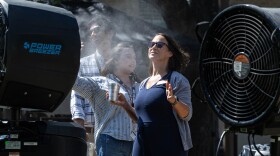The full calendar of festivals, football and other events in and around Austin certainly lets us know that October is here, but the weather feels like fall has not arrived yet.
CBS Austin morning meteorologist Avery Tomasco says this is the driest start ever to the fall season, at least in Austin's recorded history. And he says this October has been the second hottest on record.
October is usually Austin's second rainiest month of the year, with May being the rainiest. Even though the National Weather Service says we may get a little rain later this week, the Austin area seems stuck in this pattern.
KUT's Jennifer Stayton talked with Tomasco on Morning Edition about why Central Texas has been so hot and dry — and when this warm weather might end.
The transcript of this conversation below has been shortened and edited lightly for clarity.
Jennifer Stayton: Put this weather in some context. What has this October been like compared to what it is usually like?
Avery Tomasco: The midpoint in October should have temperatures in the low 80s. 83 is the average. Where have we been lately? Very steadily every single day [is] 90 to 95 degrees. In fact, the last 38 days had highs in the 90s. Not an unprecedented streak, but still exceptionally, consistently above average.
The most important part of the fall season — and very important to the Central Texas ecology, the landscape — [is] rainfall, which we have not had a drop of yet in the month of October. That's also not unprecedented. But what is unprecedented is the consistency with which it has been dry since Sept. 1, which loosely marks the start of the fall rainy season.
We've had 0.08 inches of rain in the city of Austin. So less than one-tenth of an inch. To date, we should have about half of what we get in the fall rainy season, which should be more than 5 inches. So what has fallen from the sky is less than 2% of what we should have to date.
Stayton: Can you talk about why we're in this situation — why it has been hotter and drier than we would normally be seeing at this time of year?
Tomasco: One of the bigger culprits at play is La Niña. The El Niño Southern Oscillation is the patternless fluctuation between El Niño, which is warmer than average sea surface temperatures along the equator in the Pacific Ocean. The flip side of that is La Niña. La Niña is bad for Texas. When La Niña’s in place, it changes the behavior of the jet stream.
The jet stream is largely what we rely on, outside of tropical systems, to get rain and storm systems and cold fronts to move through. When La Niña is in place, the jet stream is typically displaced farther toward the north. If the jet stream's farther away from us, fewer storm systems [mean] fewer cold fronts.
There's another culprit at play, and these are working hand-in-hand with La Niña. A very warm sea surface temperature blob, if you will, in the northern Pacific. That works in conjunction with La Niña by strengthening high pressure over the Gulf of Alaska, which further displaces the jet stream toward the north.
It can still dive down, but when it does, it's usually farther toward the north and east of us, which means we can still get these glancing blows of a cold front every now and then. But we're not getting the meat and potatoes of that cold air, nor are we getting the necessary ingredients to help generate rain and storms.
Stayton: How long are we going to be stuck in this pattern?
Tomasco: In general, I will refer to the Climate Prediction Center because I think they've got it handled pretty well with the way everything is stacked up against us. They're forecasting for the rest of the fall [to have] warmer than average, hotter than average and drier than average conditions for the southern U.S., which is oftentimes the case. And almost in every case in the La Niña situations we've been in dating back to 2020-2021 that has been the results.
Even when you think back to the February 2021 winter storm, extremely cold, right? Extremely wet. We had snowstorms. We had ice storms. Even that winter ended up averaging warmer and drier than average, even with that big winter storm in mind. It's not guaranteed that La Niña and that warm blob are going to, for sure, keep us hot and dry. But when you put months and months together, it's a high likelihood that is going to be the result.
The only saving grace that we have is that this is likely to be a pretty short-lived La Niña with a pretty rapid bounce back to neutral or even El Niño conditions heading into the first half of spring 2026.
Stayton: You're active on social media, and you are not shy about sharing your feelings about the weather. What does it feel like when our weather conditions are not ideal or not what they should be at this time of year?
Tomasco: As a meteorologist — public-facing — I am the recipient of a lot of messages, comments and concerns from the public. So when there is such a widespread disparity in what we should have and what we're actually seeing, I get a lot of feedback from folks that are struggling with it.
Folks that have property that's going dry, they're worried about mowing because they don't want to kick a rock with a mower and start a fire for their neighborhood, especially in rural areas. Farmlands, people with stock tanks and cattle, any sort of livestock. They are struggling to keep their livestock fed and watered when it is this dry.
Personally, I feel personally victimized by Mother Nature because this is the second fall season in a row where I have had so little to talk about other than how hot is it going to be.
How far into the future do we have to look to see any sort of rainfall on the map? And that kind of makes my job harder because I still have to be on TV. I still have to tell people important information. I have to dig a little deeper and work a little harder to find relevant stuff that people want to find and that keeps them glued to the TV.
Eventually it's going to change. Momma Nature will eventually get with the program. We'll have something exciting going into the rest of this season eventually, but not right now. So I'm a little bored.






